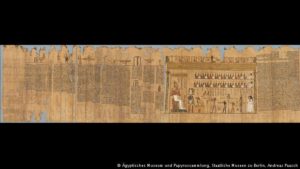Although ancient Egypt and China never communicated with each other, they had many things in common. The exhibition “China and Egypt. Cradles of the World” shows inventions made in both countries a long time ago.

Plagiarism and industrial espionage may in some cases explain why a particular invention turns up far away from where it was originally invented. But what about such cases when these possible explanations have been ruled out and two inventors incidentally develop the same idea?
Take, for example, horse snaffles – a longish mouth piece made of bronze that is kept flexible by two interlocking rings in the middle enabling the rider to steer the horse to the right or left. Two such snaffles can be admired in the special exhibition “China and Egypt. Cradles of the World” that runs in Berlin’s Neues Museum from July 6 to December 3, 2017. One of them, dated to 1,200 BC, was found in Egypt, and the other one, dated a bit later, in China. The possibility that the Chinese copied the invention from the Egyptians has been ruled out as these two ancient civilizations had no contact with each other at this stage.
The same solutions to the same problems
Back then, traveling merchants and couriers were capable of bridging enormous distances of up to 3,000 kilometers. But they could never have overcome the 8,000-kilometer distance between China and Egypt. And yet, these two civilizations seen as the world’s earliest ones, developed numerous similar inventions, institutions and traditions – not only concerning instruments of daily life, but also religious rites like the death cult and other religious concepts.
“When people feel an urge for having a stable roof over their heads, or cloth that embellish and protect them, they are quite likely to come up with similar solutions,” explains Friederike Seyfried who, together with curator Mariana Jung, is in charge of the exhibition. Sooner or later, almost every culture has invented the needle after experimenting with fish bones, pin feathers or little bones. And in the same way, people came up with similar answers to abstract questions about God and the hereafter.
From Shanghai to Berlin
Friederike Seyfried is the director of the Egyptian Museum and the papyrus collection. Roughly half of the 250 exhibits of the current Berlin exhibition originate from there. The other half comes from loans of the Shanghai Museum with whom Berlin’s state museums are cooperating. Both museums came up with the idea to initiate a common exhibition including items from 4,500 BC until 300 AD in the Greek-Roman era.
After all, it’s an important social anthropological question that makes this exhibition so interesting. How do human civilizations develop? And what are man’s solutions to particular problems?
The exhibits are not presented chronologically, but in terms of five big topics: daily life, writing, power, death cult and deities.
More: How ancient China and Egypt developed similar structures
























